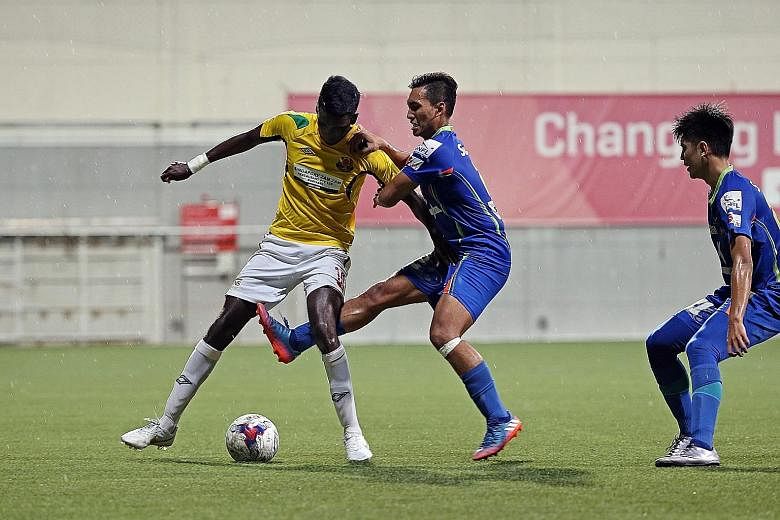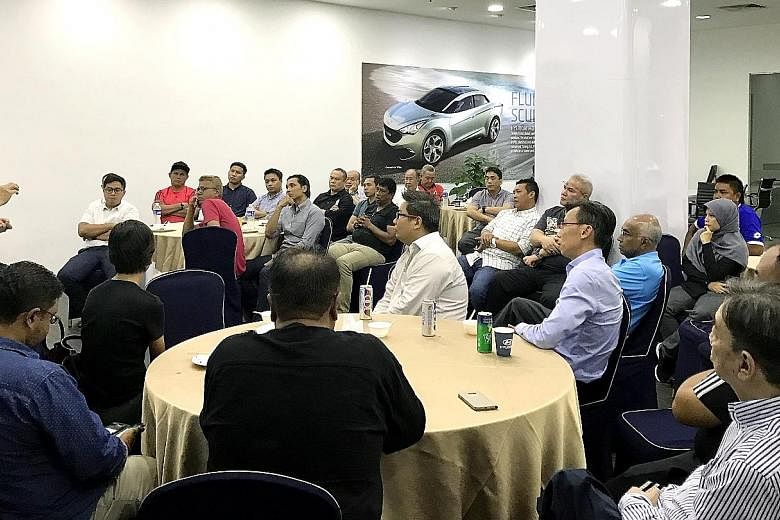Yishun Sentek Mariners were presented with the National Football League (NFL) Division One trophy on Wednesday at the Jalan Besar Stadium, their celebratory photos making the rounds on various social media platforms.
But it was not Yishun's success that was talked about on the football grapevine. On the contrary, their broad smiles were used as a symbol for the joke that was this year's NFL.
League leaders Yishun were locked in a two-horse race for the title with Singapore Armed Forces Sports Association (Safsa) going into Wednesday's final round, but Yishun did not have to kick a ball to win the championship after a walkover win against Katong FC, who were unable to field enough players for a starting XI.
Both Yishun and Safsa were also involved in a mass brawl last month and have yet to face any sanctions from the Football Association of Singapore (FAS).
As part of his campaign manifesto before winning the FAS presidency, Lim Kia Tong had called for a revamp of the NFL, a largely amateur league founded in 1975.
One of his goals was to transform the NFL into the second tier of the S-League, but observers believe this dream is light years away - and not because of a lack of talent.
From players' fitness levels to commitment and discipline to backroom issues stemming from poor administration, there are many improvements required among the 23 NFL clubs across the two divisions.
CLUBS' LACK OF FINANCIAL MUSCLE
The financial strength of clubs are widely varied. While some teams cost between $30,000 and $40,000 to operate annually, most have a yearly budget of between $10,000 and $15,000.
Most of these funds come from the pockets of officials who manage the teams, while others seek sponsors to pad up the $8,500 that NFL clubs received in subsidies from the FAS this year.
Funds are generally utilised to purchase kits, book training venues and match-day expenses such as drinks for players.
While some clubs pay their players allowances to play - between $200 and $600 - others like those from NFL Division 1 side Singapore Cricket Club (SCC) have to purchase memberships - starting from $320 annually - to qualify, effectively paying to play.
Some pay win bonuses of $50 for all games, others only for important fixtures, with some offering none.
In contrast, S-League sides run on an annual budget of about $1.5 million, with average monthly wages of $3,000.
What financial muscle brings to the table is the ability to hire a backroom complete with qualified coaches, administrators, physios and even staff to handle basic logistics likes match-day drinks and kit.
MANAGEMENT ISSUES A RECURRING THEME
Sources reveal that NFL clubs have for years struggled with administration duties, from missing deadlines for registration before the start of the season, to late submission of documents to claim the FAS subsidy.
"The FAS is already looking into getting NFL officials trained in the management of clubs and clubs' finances, and I believe this is a very important step to helping NFL clubs improve," said former Woodlands Wellington official R. Vengadasalam, who has worked with several NFL clubs until as recently as early this year.
He pointed to the FAS' promise of sending NFL coaches for upgrading as another critical policy aimed at trying to professionalise the league.
"There have been problems with administration issues, but it is also important that clubs themselves want to upgrade themselves to be closer to professional standards," he added.
CHANGING THE AMATEUR FOOTBALLER MINDSET
NFL clubs have lobbied the FAS for help to secure football pitches, but not all clubs are fully committed to a strict training regimen.
Some train up to three times a week, while others merely play a midweek friendly game in preparation for the weekend's fixtures.
This season alone, there have been at least four incidents of clubs failing to turn up for a game with enough players to kick off.
"We train three times a week, and take an almost professional approach to the game," said Safsa's former S-League player Ignatius Ang, who understands the amateur mindset of some clubs.
"I don't blame them. Some people come after work to play, they don't get paid, so you cannot expect them to commit so much, or to give everything in a match at the risk of getting injured - that's the biggest difference from the S-League," added Ang, who has earned a contract to rejoin S-League side Warriors FC next May.
Others like former Geylang International goalkeeper Yazid Yasin, who played 21 seasons in the S-League, cannot accept the malaise that has led to teams not showing up.
"This is not a Sunday league, and even in social games you don't see this happening so much," said the Gymkhana FC player. "I think clubs should work with the FAS to find a date that both teams can ensure they make it, especially for postponed games. But, for scheduled fixtures, this cannot happen."
DIFFERING STANDARDS ACROSS THE PYRAMID
Until Great Eastern Singapore came on board this season, there was no league-wide insurance coverage for the NFL - unlike for the S-League.
Tellingly, the passing mark for the 2.4km fitness test between the S-League and NFL is also different.
For the S-League, it is 9min 30sec for outfield players and 12min for goalkeepers. For the NFL, it is 11min and 13min respectively.
SCC's Dinesh Natarajan said his club are lucky to have strong off-the-field support and a good pitch to train on at the Padang, but reveals other challenges to commitment.
"It's very difficult to manage time between work and football," added the 24-year-old who is in the legal profession. "I'll have to head to training, then go back to the office to get work done. And because of things like this, maintaining fitness is a huge challenge."
With such a broad spectrum of issues that needs to be addressed, football administrators have their work cut out to bridge the gap between Singapore football's top tier and its second tier.
Even then, not everyone is convinced. Shaheer Afiq, 25, who plays for Police Sports Association in NFL Division 1, said: "I play in the NFL just to enjoy competitive football after I stopped playing in the Prime League three years ago.
"It's competitive, but more relaxed, you don't have to put in as much effort as compared to the S-League.
"It used to be a career goal to play in the S-League, but I think I've played enough."



